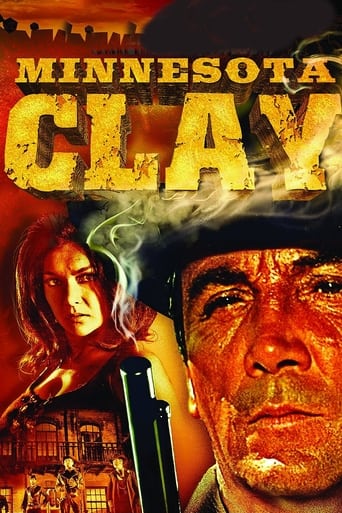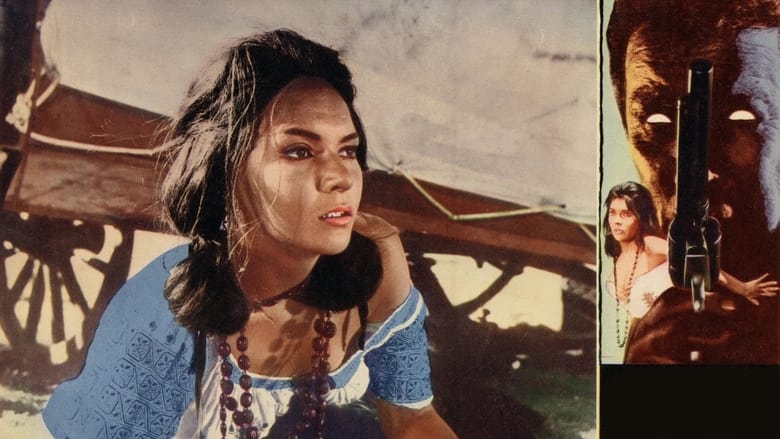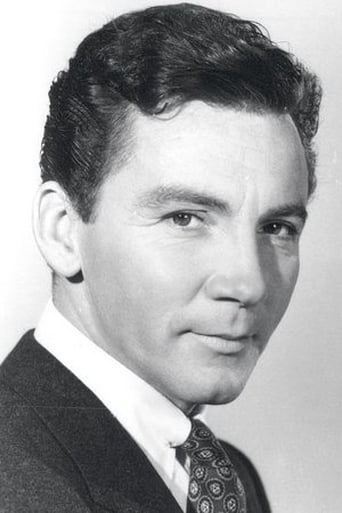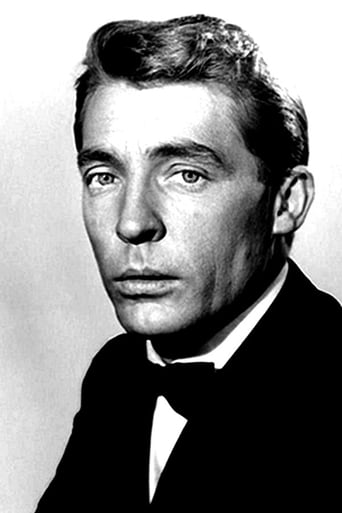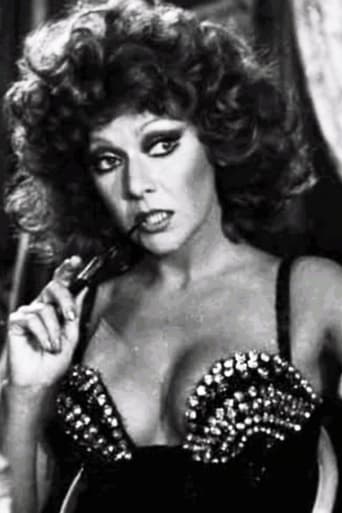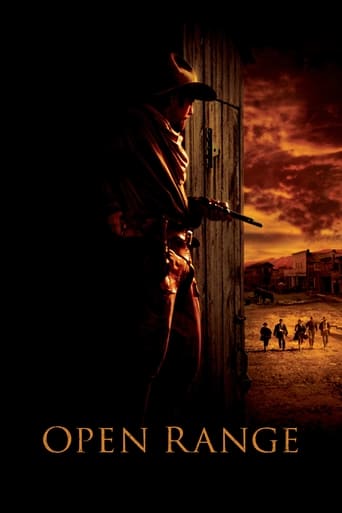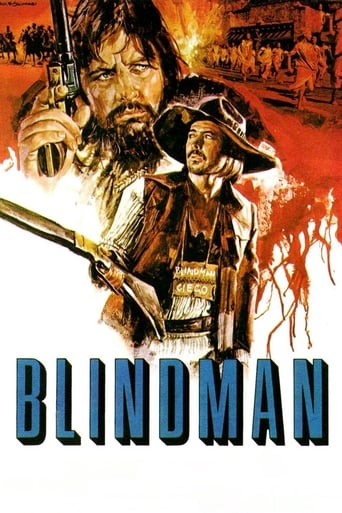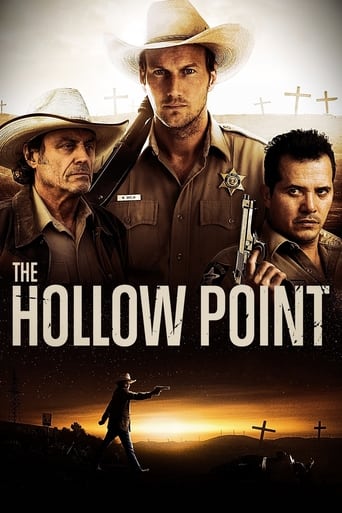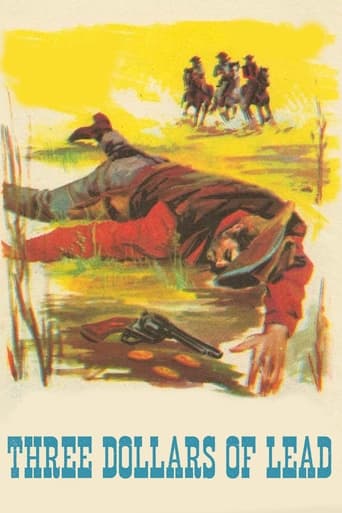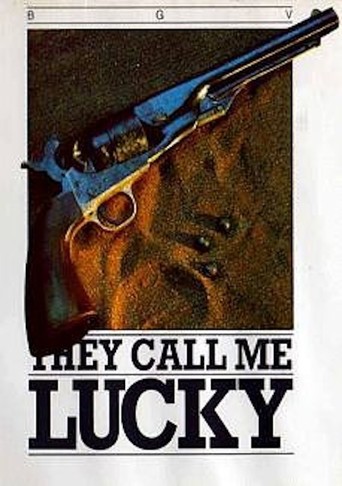Minnesota Clay (1966)
Wrongfully imprisoned for a crime he didn't commit, Minnesota Clay seeks revenge on the man who withheld evidence at his trial. There is a problem however, he is going blind.
Watch Trailer
Cast


Similar titles
Reviews
Instant Favorite.
If you don't like this, we can't be friends.
Story: It's very simple but honestly that is fine.
It is an exhilarating, distressing, funny and profound film, with one of the more memorable film scores in years,
Cameron Mitchell followed several other American actors to Europe in the 1960s and starred in several films, including westerns and sword & sandal sagas. "Django" director Sergio Corbucci cast him as a veteran gunslinger in "Minnesota Clay" who is losing his sight. Nevertheless, Mitchell's Clay remains as fast on the draw and as accurate ever with his six-gun. For the record, "Minnesota Clay" represented Corbucci's first oater to helm after sharing directorial credit with Albert Band on "Grand Canyon Massacre," starring virile Jim Mitchum. Unlike Corbucci's later westerns for which he is better known, including "Django," "Navajo Joe," "The Great Silence," "The Mercenary," and "Companeros," "Minnesota Clay" qualifies as a more conventional sagebrusher in the mold of traditional American model with few of the sudden, nimble reversals of a Spaghetti western. One trope that "Minnesota Clay" adheres to in the Spaghetti western formula is its high body count. Corbucci co-wrote the screenplay with sometime collaborator Adriano Bolzoni. As it turns out, Bolzoni supplied the story for Sergio Leone's "A Fistful of Dollars." Interestingly, when you compare the plots of both "A Fistful of Dollars" and "Minnesota Clay," the similarities are noticeable. The two films resemble Japanese filmmaker Akira Kurosawa's vintage samurai saga "Yojimbo." An outsider rides into a town that two separate fractions are warring to dominate. The chief difference between the two films is that Kurosawa sued Leone for copyright infringement but ignored Corbucci's western."Minnesota Clay," for the most part, resembles a standard-issue American horse opera about a gunfighter searching for redemption. Mitchell is dutifully straight-forward as the quick-draw protagonist who wants to change his life. Clay escapes from a brutal prison camp after he takes the camp's doctor hostage at gunpoint. He rides back to his hometown of Mesa Encantada to find a man, Fox (Georges Rivière of "The Longest Day"), who can clear him of the crime that landed him in the hell-hole of Drunner Prison. When our hero arrives in town, he learns that two rival factions are tangling over the town. First, a villainous American named Fox rules Mesa Encantada like a racketeer and forces the town's merchants into paying astronomical protection fees. Were this not enough, Fox serves as the town's marshal so he controls the law in Mesa Encantade with an iron fist. Nobody in town likes Fox, and everybody would love to see him deposed. Second, a slimy stereotypical Mexican bandit General Domingo Ortiz (Fernando Sancho of "Gunfight at High Noon"), who is as dimwitted as he is gullible, wants to see Fox bite the dirt. He hopes Clay will join him. In the middle of all, two women pursue different aims. First, sweet young Nancy Mulligan (Diana Martín of "Revenge of the Black Knight") who lives just outside of town. She has been told that her father died years ago. One of the movie's revelations is that her father is none other than Minnesota Clay. Corbucci stages a typical American western scene where Nancy struggles to halt a runaway team and Clay rides heroically to her rescue. Second, the treacherous Estella (Ethel Rojo of "Doomed Fort") learns that her treachery doesn't endear her to anybody. She facilitates Clay's escape from Ortiz's camp. Estella informs Ortiz that Clay not only has fled, but he also has stolen Ortiz's box of gold. Surprisingly, Estella has aligned herself with Fox and tells him that Ortiz is heading toward the Mulligan Ranch. Fox assembles his men and rides to the ranch. Meantime, Clay and company knock off high numbers of Ortiz's riders out of their saddles. Ortiz sets fire to the building that our heroes have sought as refuge. The above-average "Minnesota Clay" ranks far down on the list of Corbucci's westerns. But it was a beginning for the gifted Italian. The blind gunfighter premise is novel. Incidentally, the Mesa Encantade town set is the same location that Leone used for San Miguel in "A Fistful of Dollars." Altogether, this Corbucci western contains seeds that foreshadow some of his ideas and techniques in his later westerns.
One of the earliest Spaghetti Westerns directed by a pre-Django Sergio Corbucci, this film was indeed, fun to watch and you don't need braille to see that. It's a huge upgrade from his lousy previous film, 1964's Grand Canyon Massacre; a film that doesn't feel like a Spaghetti Western film. Between the time of Grand Canyon Massacre release and the making of Minnesota Clay, a little film call 1964's Fistful of Dollars by Director Sergio Leone came out and change how Italian westerns films would be made. The film would be, more violent, cynical, and have more complex gritty darker story lines. You really see, how much Sergio Leone's film influence the making of this film. The year is 1883, Minnesota Clay (Cameron Mitchell) has just escape from a prison labor Camp. Determined to prove his innocence, he return home to confront the man that framed him, Sheriff Fox (Georges Rivière) whom terrorizing and extorting the town folks for years. Now Minnesota Clay is one fast guy with a gun. Possibly the fastest in the world. Unfortunately he is also slowly losing his eyesight, with his vision now so impaired that one more blow to the face could cause complete loss of sight. To make the conflict worst, Mexican bandits leaded by a man named Gen. Domingo Ortiz (Fernando Sancho) wants to take over the town, no matter whom is the winner. The whole concept of the rivaling gangs (Mexican vs. American) wanting control of a little town, resemble the premise of 1966's "Django" as well as Leone's Fistful Of Dollars in which both were based on Akira Kurosawa's masterpiece 1961's Yojimbo, which in return is based off, the 1929's novel, 'Red Harvest' by author, Dashiell Hammett. The whole idea of a blind man taking on gangs, were taken from the Japanese's Zatoichi's series of films, like 1962's The Tale of Zatoichi & 1962's Zatoichi on the Road. Most of this movie's story ideas, came from director, Robert D. Webb's 1956 hit, 'The Proud Ones' in which the protagonist has to deal with his old nemesis, as well as recurring bouts of blindness. So, the story and plot isn't anything new. Still, the film packs violent shootouts, a really high body-count and action pack scenes. The whole runaway wagon was very entertaining to watch. Lot of crane shots and elaborate pans, truly filling the widescreen frame. You really get the scope of how big the gangs are, with these shots. The acting is pretty good for the most part. Special mention to Fernando Sancho in his ordinary role as the fat Mexican bandit that always fun to watch. George Riviere was alright in the role, but way over shadow by Sancho. He hardly stood out. He clearly isn't in his element in a western context: it would be his only spaghetti western. The women in the film are just beautiful. I have to say, Diana Martin as Nancy was just wonderful. Another was Ethel Rojo as Estella who is as devious as she is beautiful was fun to watch. It was nice to see women have complex roles. There was only one annoying character; that the film could do without, and that's the talkative and clumsy admirer, Andy (Alberto Cevenini). He comes off as a Spaghetti Western version of Jar Jar Binks!! Cameron Mitchell was great in the main role, and you really see his acting chops in the more emotional scenes. While, the acting is good, the whole English dubbing dialogue sounds a bit off. It really didn't match, the lip movement at all. The music score by Piero Piccioni really didn't stand out. Still, it was later featured in the video game 2004's Red Dead Revolver. The stunt work is dangerous in some scenes, the horses & stuntmen really took some awful falls. The movie would influence other films such as 1966's 'An eye for eye¨ by Michael Moore, 1971's 'Blindman' by director Ferdinando Baldi and 1994's ¨Blind Justice¨ by Richard Spence. The movie is a bit aged, but the DVDs out there like the ones from St. Clair Entertainment are in good copies. Due to the low bitrate, there are some smudgy outlines, especially during sideward pans, but colors are vivid and print damage is reduced to some hairs and scratches. The audio is loud and clear, but there are quite a few dropouts. The movie has various endings to this film. Two different versions were made, a shorter one with an unhappy, and one with an added-on happy ending. Some copies of the film, end with Clay lying apparently dead in the street, with Nancy at his side, but in the Italian version, there is a version, where Clays rides off alive and his sight completely restored. The dying ending was a bit off putting. Overall: Watch it yourself, whatever ending you prefer. It's simply a must-see from the early years of the Spaghetti Western.
Before you watch "Minnesota Clay", I have one bit of warning. Apparently, multiple versions of the film were made depending on what country showed the film. Now of course this makes sense with dubbed films, but I am talking about making the film with DIFFERENT endings depending on the country. This is the second Italian western that features a happy ending in the Italian version and a less happy American version. Now here's the rub--you get BOTH COMBINED on the DVD of "The Fast, the Saved and the Damned" (a DVD collection of four Italian westerns). So, after the film ends, the Italian happy ending is tacked on--and it's all in Italian and with no subtitles! So, up until then, it was dubbed in English and suddenly it's all Italian!! Now I did not have a hard time following what happened (and you probably won't--especially if you are familiar with Spanish or Italian)--but others might feel incredibly frustrated and wonder what is going on in the film. My advice? Ask an Italian friend to watch it with you! The film itself is an okay western--neither a standout nor a dog. Cameron Mitchell plays a man who was sent to prison--yet there WERE folks who could testify that he was innocent but they didn't! So, he escapes and goes looking for them in order to force them to tell the authorities what they know. However, being a film, you KNOW it won't go that smoothly! Decent acting, nice music but nothing much more to make it stand out from the crowd.
Noble, shrewd, and lethal ace gunslinger Minnesota Clay (an excellent and convincing performance by Cameron Mitchell) breaks out of a federal labor camp while serving time for a crime he didn't commit. He tracks down evil corrupt sheriff Fox (nicely played with smooth oily charm by Georges Riviere), who let Clay go to jail by withholding evidence that would have exonerated him at his trial. Moreover, Clay's gotta work fast to exact revenge on Fox because his eyesight is rapidly fading. Director Sergio Corbucci, who also co-wrote the absorbing script with Jose Gutierrez Maesso, relates the engrossing story at a steady pace, maintains a fairly gritty and serious tone throughout, and stages the stirring shoot outs with real skill and aplomb. Moreover, there's no sappy sentiment or disruptive silly humor to detract from the no-nonsense revenge premise. This film further benefits from sound acting from an able cast: Mitchell impresses as a sympathetic protagonist, Riviere makes for a deliciously mean and hateful villain, plus there are commendable contributions from the luscious Ethel Rojo as the sultry, fiery, and duplicitous Estella, Diana Martin as the sweet and fetching Nancy, Antonio Roso as affable, jocular young buck Andy, the always great Fernando Sancho in one of his trademark greasy bad guy parts as vile and grubby Mexican bandit leader General Ortiz, and Antonio Casas as Clay's loyal friend Jonathan. Jose F. Aguayo's sharp widescreen cinematography offers several graceful gliding tracking shots and plenty of lovely panoramic images of the dusty landscape. Piero Piccioni supplies a moody and effective score. The big climactic confrontation with a blind Clay using his hearing to pick off Fox and his flunkies is extremely tense, gripping, and thrilling. A worthwhile movie.

